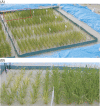Recent insights into iron homeostasis and their application in graminaceous crops
- PMID: 21084773
- PMCID: PMC3035920
- DOI: 10.2183/pjab.86.900
Recent insights into iron homeostasis and their application in graminaceous crops
Abstract
Higher plants utilize various mechanisms to maintain iron homeostasis. To acquire sparingly soluble iron from the rhizosphere, graminaceous plants synthesize natural iron (III) chelators known as mugineic acid family phytosiderophores (MAs). Recent research has uncovered various genes involved in iron uptake and translocation, as well as factors regulating the expression of these genes, especially in rice. Manipulation of these molecular components is used to produce transgenic crops with enhanced tolerance to iron deficiency, or with a high seed iron content. Since iron homeostasis is closely linked to that of other mineral elements, an understanding of this phenomenon will serve as the basis for the production of crops with low concentrations of toxic metals and transgenic plants for phytoremediation.
Figures





Similar articles
-
Structural determination of mugineic acid, an iron(III)-chelating substance secreted from graminaceous plants for efficient iron uptake.Proc Jpn Acad Ser B Phys Biol Sci. 2025;101(2):55-67. doi: 10.2183/pjab.101.007. Proc Jpn Acad Ser B Phys Biol Sci. 2025. PMID: 39924176 Free PMC article. Review.
-
The Phytosiderophore Efflux Transporter TOM2 Is Involved in Metal Transport in Rice.J Biol Chem. 2015 Nov 13;290(46):27688-99. doi: 10.1074/jbc.M114.635193. Epub 2015 Oct 2. J Biol Chem. 2015. PMID: 26432636 Free PMC article.
-
Iron uptake, translocation, and regulation in higher plants.Annu Rev Plant Biol. 2012;63:131-52. doi: 10.1146/annurev-arplant-042811-105522. Epub 2012 Jan 30. Annu Rev Plant Biol. 2012. PMID: 22404471 Review.
-
The rice bHLH protein OsIRO2 is an essential regulator of the genes involved in Fe uptake under Fe-deficient conditions.Plant J. 2007 Aug;51(3):366-77. doi: 10.1111/j.1365-313X.2007.03149.x. Epub 2007 Jun 8. Plant J. 2007. PMID: 17559517
-
Expression of iron-acquisition-related genes in iron-deficient rice is co-ordinately induced by partially conserved iron-deficiency-responsive elements.J Exp Bot. 2005 May;56(415):1305-16. doi: 10.1093/jxb/eri131. Epub 2005 Mar 21. J Exp Bot. 2005. PMID: 15781441
Cited by
-
Acquisition of Iron Is Required for Growth of Salmonella spp. in Tomato Fruit.Appl Environ Microbiol. 2015 Jun;81(11):3663-70. doi: 10.1128/AEM.04257-14. Epub 2015 Mar 20. Appl Environ Microbiol. 2015. PMID: 25795672 Free PMC article.
-
Identification of Genomic Regions Conferring Enhanced Zn and Fe Concentration in Wheat Varieties and Introgression Lines Derived from Wild Relatives.Int J Mol Sci. 2024 Sep 30;25(19):10556. doi: 10.3390/ijms251910556. Int J Mol Sci. 2024. PMID: 39408887 Free PMC article.
-
New insights into globoids of protein storage vacuoles in wheat aleurone using synchrotron soft X-ray microscopy.J Exp Bot. 2011 Jul;62(11):3929-39. doi: 10.1093/jxb/err090. Epub 2011 Mar 29. J Exp Bot. 2011. PMID: 21447756 Free PMC article.
-
A Vacuolar Membrane Ferric-Chelate Reductase, OsFRO1, Alleviates Fe Toxicity in Rice (Oryza sativa L.).Front Plant Sci. 2019 Jun 4;10:700. doi: 10.3389/fpls.2019.00700. eCollection 2019. Front Plant Sci. 2019. PMID: 31214220 Free PMC article.
-
The SUMO E3 Ligase MdSIZ1 Targets MdbHLH104 to Regulate Plasma Membrane H+-ATPase Activity and Iron Homeostasis.Plant Physiol. 2019 Jan;179(1):88-106. doi: 10.1104/pp.18.00289. Epub 2018 Oct 17. Plant Physiol. 2019. PMID: 30333149 Free PMC article.
References
-
- Marschner, H. (1995) Mineral Nutrition of Higher Plants 2nd ed. Academic press, London, UK.
-
- Mori S. (1999) Iron acquisition by plants. Curr. Opin. Plant Biol. 2, 250–253 - PubMed
-
- Grusak M.A., Dellapenna D. (1999) Improving the nutrient composition of plants to enhance human nutrition and health. Annu. Rev. Plant Physiol. Plant Mol. Biol. 50, 133–161 - PubMed
-
- Takagi S. (1976) Naturally occurring iron-chelating compounds in oat- and rice-root washing. I. Activity measurement and preliminary characterization. Soil Sci. Plant Nutr. 22, 423–433

